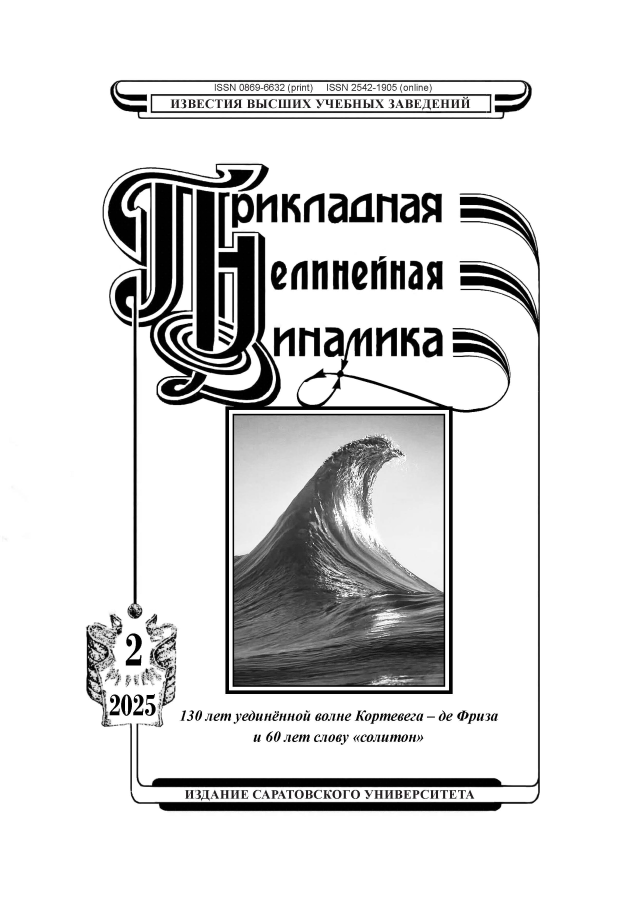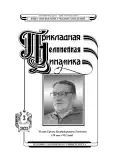Ambient light at night causes desynchronization of rhythms in the sleep–wake switching model
- Authors: Merkulova K.O.1, Postnov D.E.1
-
Affiliations:
- Saratov State University
- Issue: Vol 31, No 3 (2023)
- Pages: 351-364
- Section: Articles
- URL: https://journal-vniispk.ru/0869-6632/article/view/250960
- DOI: https://doi.org/10.18500/0869-6632-003036
- EDN: https://elibrary.ru/JFYIYI
- ID: 250960
Cite item
Full Text
Abstract
About the authors
Ksenia Olegovna Merkulova
Saratov State Universityul. Astrakhanskaya, 83, Saratov, 410012, Russia
Dmitrij Engelevich Postnov
Saratov State Universityul. Astrakhanskaya, 83, Saratov, 410012, Russia
References
- Borbely AA. A two process model of sleep regulation. Hum. Neurobiol. 1982;1(3):195–204.
- Achermann P, Borbely AA. Simulation of human sleep: ultradian dynamics of electroencephalo-graphic slow-wave activity. Journal of Biological Rhythms. 1990;5(2):141–157. doi: 10.1177/074873049000500206.
- Achermann P, Borbely AA. Simulation of daytime vigilance by the additive interaction of a homeostatic and a circadian process. Biological Cybernetics. 1994;71(2):115–121. DOI: 10.1007/ BF00197314.
- Achermann P, Dijk DJ, Brunner DP, Borbely AA. A model of human sleep homeostasis based on EEG slow-wave activity: Quantitative comparison of data and simulations. Brain Research Bulletin. 1993;31(1–2):97–113. doi: 10.1016/0361-9230(93)90016-5.
- Achermann P. The two-process model of sleep regulation revisited. Aviation, Space, and Environmental Medicine. 2004;75(Suppl 3):LA37–A43.
- Borbely AA, Daan S, Wirz-Justice A, Deboer T. The two-process model of sleep regulation: a reappraisal. Journal of Sleep Research. 2016;25(2):131–143. doi: 10.1111/jsr.12371.
- Golombek DA, Rosenstein RE. Physiology of circadian entrainment. Physiol. Rev. 2010;90(3): 1063–1102. doi: 10.1152/physrev.00009.2009.
- Kalsbeek A, la Fleur S, Fliers E. Circadian control of glucose metabolism. Molecular Metabolism. 2014;3(4):372–383. doi: 10.1016/j.molmet.2014.03.002.
- Youngstedt SD, Elliott JA, Kripke DF. Human circadian phase–response curves for exercise. The Journal of Physiology. 2019;597(8):2253–2268. doi: 10.1113/JP276943.
- Casjens S, Brenscheidt F, Tisch A, Beermann B, Bruning T, Behrens T, Rabstein S. Social jetlag and sleep debts are altered in different rosters of night shift work. PLoS ONE. 2022;17(1):e0262049. doi: 10.1371/journal.pone.0262049.
- Hulsegge G, Loef B, van Kerkhof LW, Roenneberg T, van der Beek AJ, Proper KI. Shift work, sleep disturbances and social jetlag in healthcare workers. Journal of Sleep Research. 2019;28(4):e12802. doi: 10.1111/jsr.12802.
- Sudy AR, Ella K, Bodizs R, Kaldi K. Association of social jetlag with sleep quality and autonomic cardiac control during sleep in young healthy men. Front. Neurosci. 2019;13:950. doi: 10.3389/fnins.2019.00950.
- Deacon S, Arendt J. Adapting to phase shifts, I. An experimental model for jet lag and shift work. Physiology & Behavior. 1996;59(4–5):665–673. doi: 10.1016/0031-9384(95)02147-7.
- Skeldon AC, Phillips AJK, Dijk DJ. The effects of self-selected light-dark cycles and social constraints on human sleep and circadian timing: a modeling approach. Scientific Reports. 2017;7(1):45158. doi: 10.1038/srep45158.
- Putilov AA, Verevkin EG. Simulation of the ontogeny of social jet lag: A shift in just one of the parameters of a model of sleep-wake regulating process accounts for the delay of sleep phase across adolescence. Front. Physiol. 2018;9:1529. doi: 10.3389/fphys.2018.01529.
- Harvey AG. Sleep and circadian rhythms in bipolar disorder: Seeking synchrony, harmony, and regulation. The American Journal of Psychiatry. 2008;165(7):820–829. doi: 10.1176/appi.ajp. 2008.08010098.
- Hickie IB, Naismith SL, Robillard R, Scott EM, Hermens DF. Manipulating the sleep-wake cycle and circadian rhythms to improve clinical management of major depression. BMC Medicine. 2013;11:79. doi: 10.1186/1741-7015-11-79.
- Healy KL, Morris AR, Liu AC. Circadian synchrony: Sleep, nutrition, and physical activity. Front. Netw. Physiol. 2021;1:732243. doi: 10.3389/fnetp.2021.732243.
- Rajaratnam SMW, Licamele L, Birznieks G. Delayed sleep phase disorder risk is associated with absenteeism and impaired functioning. Sleep Health. 2015;1(2):121–127. doi: 10.1016/j.sleh. 2015.03.001.
- Sack RL, Auckley D, Auger RR, Carskadon MA, Wright Jr KP, Vitiello MV, Zhdanova IV. Circadian rhythm sleep disorders: Part II, advanced sleep phase disorder, delayed sleep phase disorder, free-running disorder, and irregular sleep-wake rhythm. Sleep. 2007;30(11):1484–1501. doi: 10.1093/sleep/30.11.1484.
- Tekieh T, Lockley SW, Robinson PA, McCloskey S, Zobaer MS, Postnova S. Modeling melanopsin mediated effects of light on circadian phase, melatonin suppression, and subjective sleepiness. Journal of Pineal Research. 2020;69(3):e12681. doi: 10.1111/jpi.12681.
- Postnova S, Lockley SW, Robinson PA. Sleep propensity under forced desynchrony in a model of arousal state dynamics. Journal of Biological Rhythms. 2016;31(5):498–508. DOI: 10.1177/ 0748730416658806.
- Dong E, Liang Z. The multi-frequency EEG rhythms modeling based on two-parameter bifurcation of neural mass model. In: 2014 IEEE International Conference on Mechatronics and Automation. 03-06 August 2014, Tianjin, China. New York: IEEE; 2014. P. 1564–1569. doi: 10.1109/ICMA. 2014.6885933.
- Weigenand A, Schellenberger Costa M, Victor Ngo HV, Claussen JC, Martinetz T. Characterization of K-complexes and slow wave activity in a neural mass model. PLoS Comput. Biol. 2014;10(11): e1003923. doi: 10.1371/journal.pcbi.1003923.
- Phillips AJK, Robinson PA. A quantitative model of sleep-wake dynamics based on the physiology of the brainstem ascending arousal system. Journal of Biological Rhythms. 2007;22(2):167–179. doi: 10.1177/0748730406297512.
- Phillips AJK, Czeisler CA, Klerman EB. Revisiting spontaneous internal desynchrony using a quantitative model of sleep physiology. Journal of Biological Rhythms. 2011;26(5):441–453. doi: 10.1177/0748730411414163.
- St Hilaire MA, Klerman EB, Khalsa SBS, Wright Jr KP, Czeisler CA, Kronauer RE. Addition of a non-photic component to a light-based mathematical model of the human circadian pacemaker. Journal of Theoretical Biology. 2007;247(4):583–599. doi: 10.1016/j.jtbi.2007.04.001.
- Berson DM. Strange vision: ganglion cells as circadian photoreceptors. Trends in Neurosciences. 2003;26(6):314–320. doi: 10.1016/S0166-2236(03)00130-9.
- Wong KY, Dunn FA, Graham DM, Berson DM. Synaptic influences on rat ganglion-cell photoreceptors. The Journal of Physiology. 2007;582(1):279–296. doi: 10.1113/jphysiol. 2007.133751.
- Kloeden PE, Platen E. Higher-order implicit strong numerical schemes for stochastic differential equations. Journal of Statistical Physics. 1992;66(1–2):283–314. doi: 10.1007/BF01060070.
- Khodabin M, Rostami M. Mean square numerical solution of stochastic differential equations by fourth order Runge-Kutta method and its application in the electric circuits with noise. Advances in Difference Equations. 2015;1:62. doi: 10.1186/s13662-015-0398-6.
- Rackauckas C, Nie Q. Adaptive methods for stochastic differential equations via natural embeddings and rejection sampling with memory. Discrete and Continuous Dynamical Systems - B. 2017;22(7): 2731–2761. doi: 10.3934/dcdsb.2017133.
- Pikovsky A, Rosenblum M, Kurths J. Synchronization: A Universal Concept in Nonlinear Sciences. Cambridge: Cambridge University Press; 2001. 432 p. doi: 10.1017/CBO9780511755743.
- Balanov A, Janson N, Postnov D, Sosnovtseva O. Synchronization: From Simple to Complex. Berlin, Heidelberg: Springer; 2008. 426 p. doi: 10.1007/978-3-540-72128-4.
- Postnov DE, Balanov AG, Sosnovtseva OV, Mosekilde E. Chaotic hierarchy in high dimensions. International Journal of Modern Physics B. 2000;14(24):2511–2527. DOI: 10.1142/ S0217979200002296.
- Zeitzer JM, Dijk DJ, Kronauer RE, Brown EN, Czeisler CA. Sensitivity of the human circadian pacemaker to nocturnal light: melatonin phase resetting and suppression. The Journal of Physiology. 2000;526(3):695–702. doi: 10.1111/j.1469-7793.2000.00695.x.
- Postnov DE, Merkulova KO, Postnova S. Desynchrony and synchronisation underpinning sleep– wake cycles. The European Physical Journal Plus. 2021;136(5):488. doi: 10.1140/epjp/s13360- 021-01491-z.
Supplementary files










